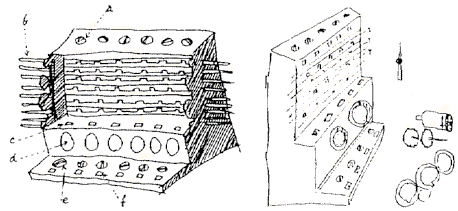Fragment of
Schickard’s letter sent to Kepler in September 20,
1623:
"What you have done by calculation I have just tried
to do by way of mechanics. I have conceived a machine
consisting of eleven complete and six incomplete sprocket
wheels; it calculates instantaneously and automatically
from given numbers, as it adds, subtracts, multiplies and
divides. You would enjoy to see how the machine
accumulates and transports spontaneously a ten or a
hundred to the left and, vice-versa, how it does the
opposite if it is subtracting ... "
Fragment of Schickard’s letter sent to
Kepler in February 25, 1624:
“… In other opportunity I will send you a more
detailed description of the design of this arithmetic
machine; in summary, it works like this: aaa are
the buttons of the vertical cylinders with the digits of
the multiplication table, which can be displayed at will
in the windows provided for the slides bbb. The
dials ddd are attached to internal toothed
wheels, each one having ten teeth geared in such a way
that, if the wheel of the right makes ten turns, the
wheel on its left makes only one turn; and if the first
wheel on the right side makes one hundred turns, the
third wheel on the left makes one turn, and so on.
All the wheels rotate in the same direction making it
necessary the use of another wheel of the same size
geared permanently to the wheel at its left, but not with
the one at its right, which requires a special attention
during its construction. The digits marked in each wheel
are displayed in the openings ccc of the central
plate.
Finally, over the base are located the buttons eee
used to note in the openings fff the numbers
that need to be used during the operations. This brief
description would be better understood by using the real
instrument.
I had placed an order with a local man, Johan Pfister,
for the construction of a machine for you; but when half
finished, this machine, together with some other things
of mine, especially several metal plates, fell victim to
a fire which broke unseen during the night, three days
ago. I take the loss very hard, especially, since there
is no time to produce a replacement soon.”
|
